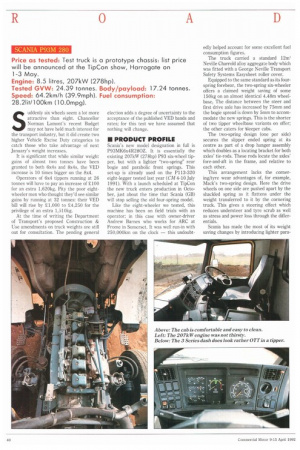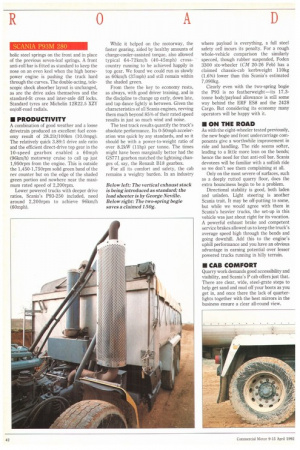S uddenly six wheels seem a lot more attractive than eight.
Page 42

Page 44

Page 45

If you've noticed an error in this article please click here to report it so we can fix it.
Chancellor Norman Lamont's recent Budget may not have held much interest for the transport industry, but it did create two higher Vehicle Excise Duty categories to catch those who take advantage of next January's weight increases.
It is significant that while similar weight gains of almost two tonnes have been granted to both 6x4s and 8x4s, the VED increase is 10 times bigger on the 8x4.
Operators of 6x4 tippers running at 26 tonnes will have to pay an increase of 2.100 for an extra 1,620kg. Pity the poor eightwheeler men who thought they'd see similar gains by running at 32 tonnes: their VED bill will rise by £1,000 to £4,250 for the privilege of an extra 1,510kg.
At the time of writing the Department of Transport's proposed Construction & Use amendments on truck weights are still out for consultation. The pending general election adds a degree of uncertainty to the acceptance of the published VED bands and rates; for this test we have assumed that nothing will change.
• PRODUCT PROFILE Scania's new model designation in full is P93MK6x4R280Z. It is essentially the existing 207kW (278hp) P93 six-wheel tipper, but with a lighter "two-spring" rear bogie and parabolic front springs. This set-up is already used on the P113-320 eight-legger tested last year (CM 4-10 July 1991). With a launch scheduled at TipCon the new truck enters production in October, just about the time that Scania (GB) will stop selling the old four-spring model.
Like the eight-wheeler we tested, this machine has been on field trials with an operator; in this case with owner-driver Andrew Barnes who works for ARC at Frome in Somerset. It was well run-in with 250,000km on the clock — this undoubt
edly helped account for some excellent fuel consumption figures.
The truck carried a standard 12m' Neville Charrold alloy aggregate body which was fitted with a George Neville Transport Safety Systems Easysheet roller cover.
Equipped to the same standard as its fourspring forebear, the two-spring six-wheeler offers a claimed weight saving of some 150kg on an almost identical 4.48m wheelbase. The distance between the steer and first drive axle has increased by 75mm and the bogie spread is down by 5mm to accommodate the new springs. This is the shorter of two tipper wheelbase variants on offer; the other caters for 'Bleeper cabs.
The two-spring design (one per side) secures the slipper ended spring at its centre as part of a drop hanger assembly which doubles as a locating bracket for both axles' tie-rods. These rods locate the axles' fore-and-aft in the frame, and relative to each other.
This arrangement lacks the cornering/tyre wear advantages of, for example, Mack's two-spring design. Here the drive wheels on one side are pushed apart by the shackled spring as it flattens under the weight transferred to it by the cornering truck. This gives a steering effect which reduces understeer and tyre scrub as well as stress and power loss through the differentials.
Scania has made the most of its weight saving changes by introducing lighter para bolic steel springs on the front and in place of the previous seven-leaf springs. A front anti-roll bar is fitted as standard to keep the nose on an even keel when the high horsepower engine is pushing the truck hard through the curves. The double-acting, telescopic shock absorber layout is unchanged, as are the drive axles themselves and the standard-fit cross and inter-axle diff locks. Standard tyres are Michelin 12R22.5 XZY on/off-road radials.
• PRODUCTIVITY
A combination of good weather and a loose drivetrain produced an excellent fuel economy result of 28.21it/100km (10.0mpg). The relatively quick 3.89:1 drive axle ratio and the efficient direct-drive top gear in the 10-speed gearbox enabled a 60mph (96km/h) motorway cruise to call up just 1,950rpm from the engine. This is outside the 1,450-1,750rpm solid green band of the rev counter but on the edge of the shaded green portion and nowhere near the maximum rated speed of 2,200rpm, Lower powered trucks with deeper drive ratios, Scania's P93-250 included, need around 2,200rpm to achieve 96km/h (60mph). While it helped on the motorway, the faster gearing, aided by healthy amounts of charge-cooler-assisted torque, also allowed typical 64-72km/h (40-45mph) crosscountry running to be achieved happily in top gear. We found we could run as slowly as 60km/h (37mph) and still remain within the shaded green.
From there the key to economy rests, as always, with good driver training, and in the discipline to change up early, down late, and tap dance lightly in between. Given the characteristics of all Scania engines, revving them much beyond 85% of their rated speed results in just so much wind and noise.
The test track results quantify the truck's absolute performance, Its 0-50mph acceleration was quick by any standards, and so it should be with a power-to-weight ratio of over 8.2kW (11hp) per tonne. The times might have been marginally better had the GS771 gearbox matched the lightning changes of, say, the Renault B18 gearbox.
For all its comfort and safety, the cab remains a weighty burden. In an industry
where payload is everything, a full steel safety cell incurs its penalty. For a rough whole-vehicle comparison the similarly specced, though rubber suspended, Foden 3300 six-wheeler (CM 20-26 Feb) has a claimed chassis-cab kerbweight 110kg (1.6%) lower than this Scania's estimated 7,090kg.
Clearly even with the two-spring bogie the P93 is no featherweight—its 17.3tonne body/payload allowance is still some way behind the ERF ES8 and the 2428 Cargo. But considering its economy many operators will be happy with it.
• ON THE ROAD
As with the eight-wheeler tested previously, the new bogie and front undercarriage components give a worthwhile improvement in ride and handling. The ride seems softer, leading to a little more lean on the bends; hence the need for that anti-roll bar. Scania devotees will be familiar with a softish ride so we don't see them complaining at all.
Only on the most severe of surfaces, such as a deeply rutted quarry floor, does the extra bounciness begin to be a problem.
Directional stability is good, both laden and unladen. Light steering is another Scania trait. It may be off-putting to some, but while we would agree with them in Scania's heavier trucks, the set-up in this vehicle was just about right for its vocation. A powerful exhaust brake and competent service brakes allowed us to keep the truck's average speed high through the bends and going downhill. Add this to the engine's uphill performance and you have an obvious advantage in earning potential over lesser powered trucks running in hilly terrain.
• CAB COMFORT
Quarry work demands good accessibility and visibility, and Scania's P cab offers just that. There are clear, wide, steel-grate steps to help get sand and mud off your boots as you get in, and once there the lack of quarterlights together with the best mirrors in the business ensure a clear all-round view.
A standard-fit driver's air suspension seat is a comfort on road, although we were glad of the Isringhausen unit's lock-out function which enabled the seat to be fixed rigid for better control in bumpy off-road conditions. Thick removable rubber floor mats make for easy cleaning.
The standard equipment check list includes electrically heated mirrors and power windows on both sides; a filtered ventilation system is a must in dusty quarry conditions.
• SUMMARY
We will have to wait for TipCon for the official launch and price, but no one is pretending it will be cheap. There have been recent moves by Scania to harden its prices on individual deals, but this remains a buyer's market. However, projected depreciation levels are at an all-time low-anyone who buys now will reap a benefit when they come to sell in three or four years time because there is bound to be a paucity of models of that age.
If the price of a two-spring eight-wheeler is any indication, the equivalent 6x4 will come out between one and 12% ahead of the field at around £50,000 list, but of course that will simply be the point at which the haggling begins. October production means that the first chassis probably won't reach dealers before mid-December, so until then look out for some good deals on outgoing four-spring models.
If you considered a Scania sixer before but were put off by its weight or the maintenance requirements for that suspension, look again. The spare parts haven't got any cheaper, but there are fewer of them. Add relatively low depreciation, good reliability, reasonable weight, high build quality and excellent fuel economy potential and this might be what you're looking for.
0 by Danny Coughlan




























































































